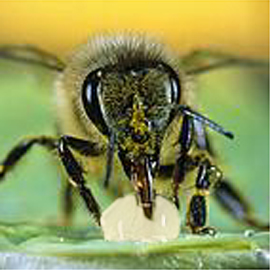What is Royal Jelly?

What is royal jelly and where does it come from? Royal jelly is a milky-white secretions mixture of flower nectars, proteins, and vitamins made from worker bees to help maintain the development of the Queen bee. Because these secretions are the only source of food that the Queen bee is fed, hence it’s named, Royal Jelly. Many of the natural nutrients and healing effects of Royal Jelly on the human body have been researched with positive outcomes. Thus, royal jelly continues to be the topic of popular studies around the world, and as results of these studies come to light, we are more convinced then ever of its natural wonders.
Royal jelly has an impressive array of nutrients containing 22 amino acids and all of the major B vitamins such as: B1, B2 (riboflavin), niacin, B5 (pantothenic acid), B6, biotin, folic acid, B12, inositol, and choline. Royal jelly also has small amounts of vitamin A, C, D and E, as well as minerals such as: calcium, copper, iron, phosphorus, potassium, silicon, and sulfur, most of which are essential nutrients. These impressive nutrients are not final. Approximately 3 percent of royal jelly’s complex content has not yet been identified, so there is more good news to come.
Researched by Roger J. Williams, Ph.D., one of the most respected biochemists, royal jelly was found to help increase the growth of the Queen bee by 40 to 60 percent larger and, lives 40 times longer than the worker bees. In his experiments, Dr. Williams confirmed that by feeding his test subjects with royal jelly daily, he was able to increase their life span by 18 percent, which translates to be about 13 additional years in the human life terms.
Studies have also shown that the pantothenic acid in royal jelly helps those who are suffering with arthritis. It is known that those who suffer from arthritis lack pantothenic acid in their blood. When panthothenic acid was introduced, their blood level became normal and the arthritis symptoms disappeared. These symptoms quickly returned when panthothenic acid was taken away. Researchers also theorized that the ingredient call 10-hydroxy-2decenoic acid (10-HDA), which has a powerful antimicrobial properties, believed in contributing to the anti-inflammatory effects, are also found in royal jelly, thus, enabling royal jelly to help relieve victims of painful swellings from their arthritis symptoms.
Royal jelly is also known for improving various physical disorders such as: recovering from loss of appetite (anorexia nervosa); improving blood circulation; reducing symptoms of arthritis and asthma; lowering of cholesterol and triglyceride levels; correction of urinary incontinence; and improvement of certain types of impotency. Based on studies, by adding royal jelly to the diets of tested animals, they grew larger, lived longer, and showed greater fertility, and became more sexually active. According to Scientists at the New York Medical College in Valhalla, N.Y., royal jelly contain a complex compound that stimulates sex glands of both men and women, just as a natural hormone would. Discoveries have also been made by French biochemists revealing that royal jelly had enhanced the treatment of sterility and sex organ insufficiencies, particularly frigidity and impotency.
In addition, royal jelly has several key ingredients that are used in the synthesizing of acetylcholine. Acetylcholine is a key neurotransmitter that relays messages from cell to cell throughout the body. As a neurotransmitter between the nerve cells and the muscles, acetylcholine partly controls the bladder, blood vessels, liver, heart, sweat glands, spleen, and stomach. Without this neurotransmitter, we would not be able to control our muscles or move and when these levels are low, we will experience memory lost, difficulty concentrating and sleeping. Acetylcholine also keeps the body’s mucous membranes properly moistened.
Studies conducted by three prestigious Canadian universities, also indicates that royal jelly may also be helpful in preventing certain types of cancers, heart diseases, and alcoholism .
Medical doctors, B. Filipic and M. Likvar found that royal jelly was helpful in treating virus infected patients especially with flu and herpes viruses. Dr. Murray S. Blum and associates at Louisiana State University discovered that royal jelly is approximately one-fourth as strong as penicillin in its antibiotic factors and royal jelly can be used without the side effects of antibiotics. It has been successfully used to stop the growth of microorganisms that causes intestinal and skin infections such as pimples and boils.
Furthermore, many of the world’s most renowned dermatologists believe that when royal jelly is added to creams, lotions, and beauty masks, and applied daily, it can have tremendous effects at the cellular level that softens the skin and helps fade away wrinkles. The gelatinous amino acid found in royal jelly provides a lasting effect in helping the skin look more firm, youthful and free of blemishes. The French beauty expert, Dr. M. Esperrois, of the French Institute of Chemistry also believes that royal jelly can reverse the effects of aging on the skin, along with correction of darken, wrinkled, and blemished areas due to aging by stimulating circulation and delivering additional nutrients with oxygen-laden blood to the skin, and stimulating cellular waste elimination. Royal jelly also contains an anti-bacterial ingredient that contributes to protect the skin from bacteria.
Royal jelly when combined with other natural resources such as bee pollen and ginseng can be used as a natural creatine for muscle developments. The result will not be identical to that of creatine, but will allow you to work out harder and longer, and recover faster while helping to keep your body in good health. For years, athletes and bodybuilders have used royal jelly as a natural supplement to help optimize their performance and overall health.



Comments for this article (19 comments)
Cảm ơn Dược thảo tre xanh giúp bạn đọc có thêm kiến thức bổ ích.
Comment for this article